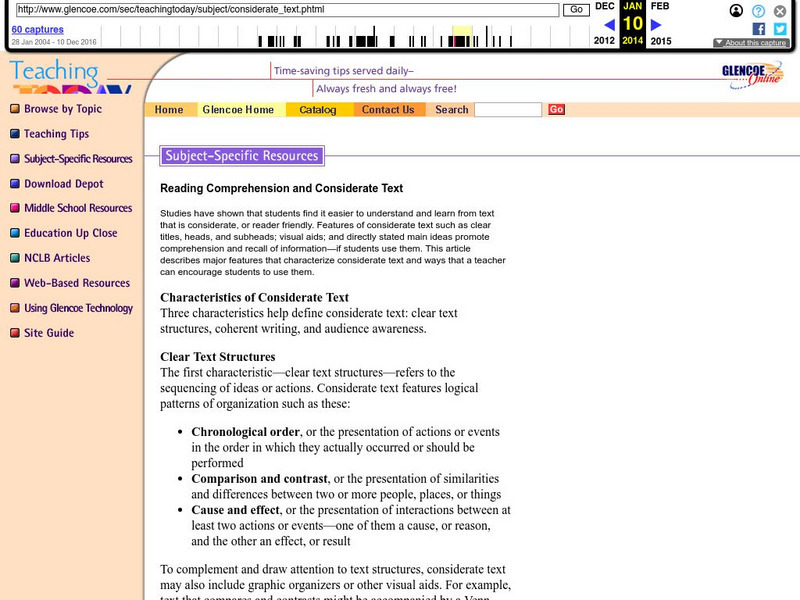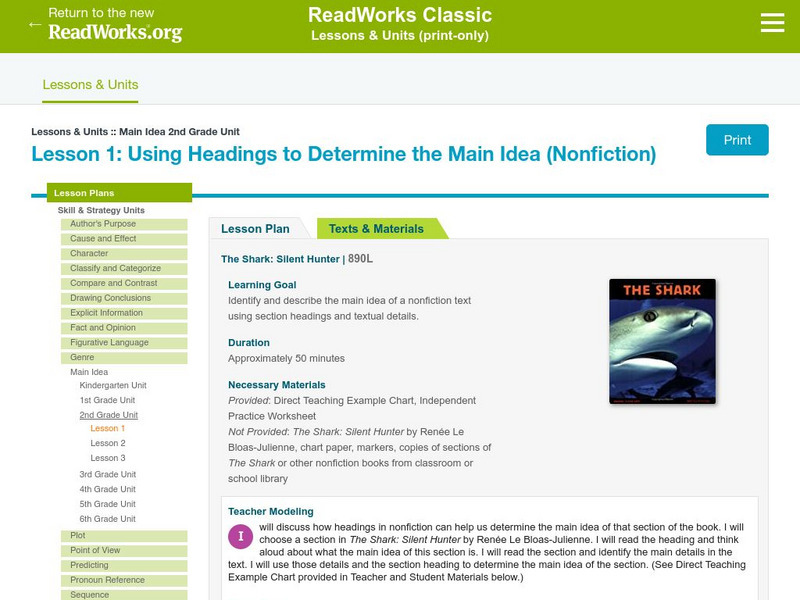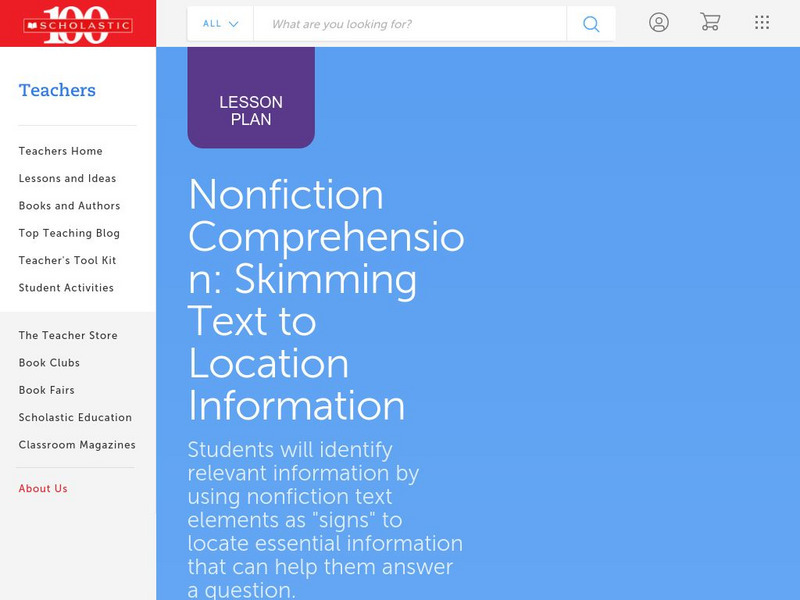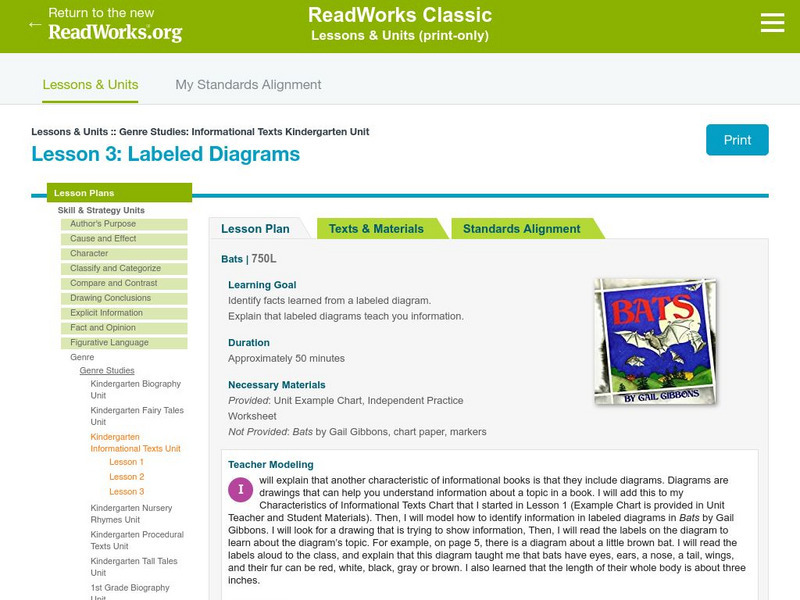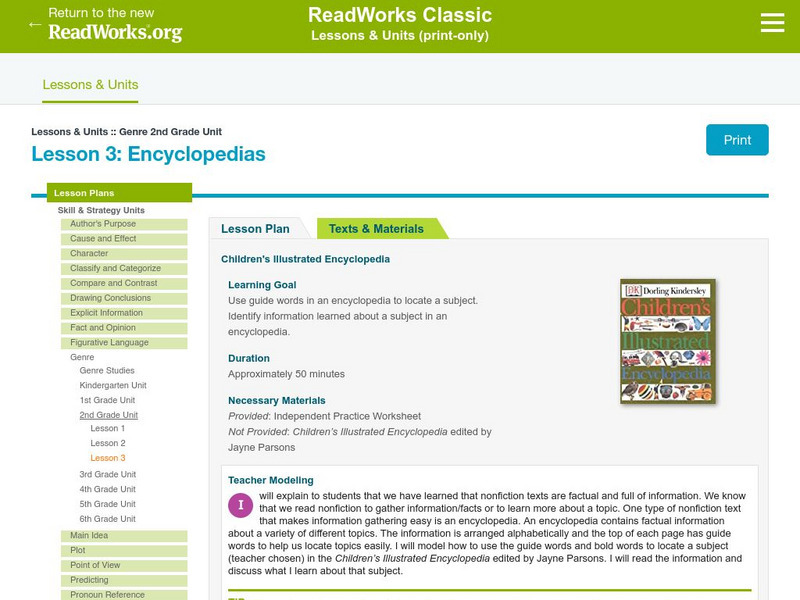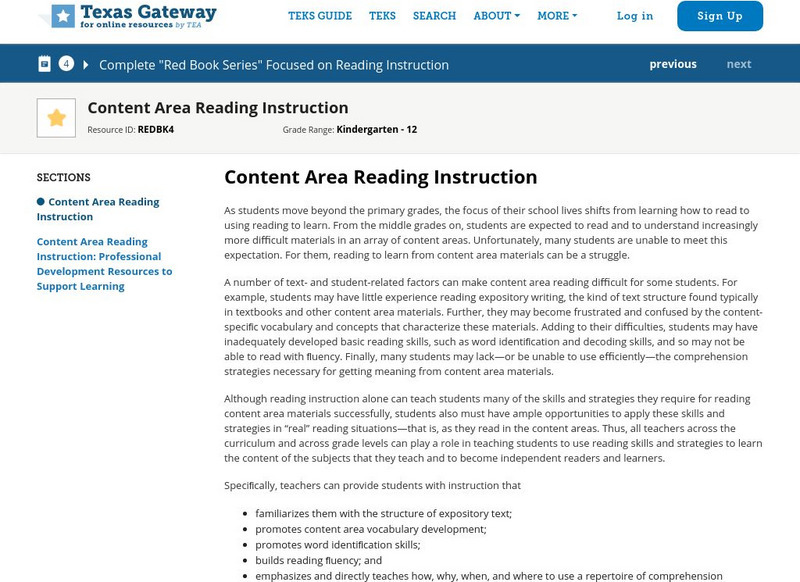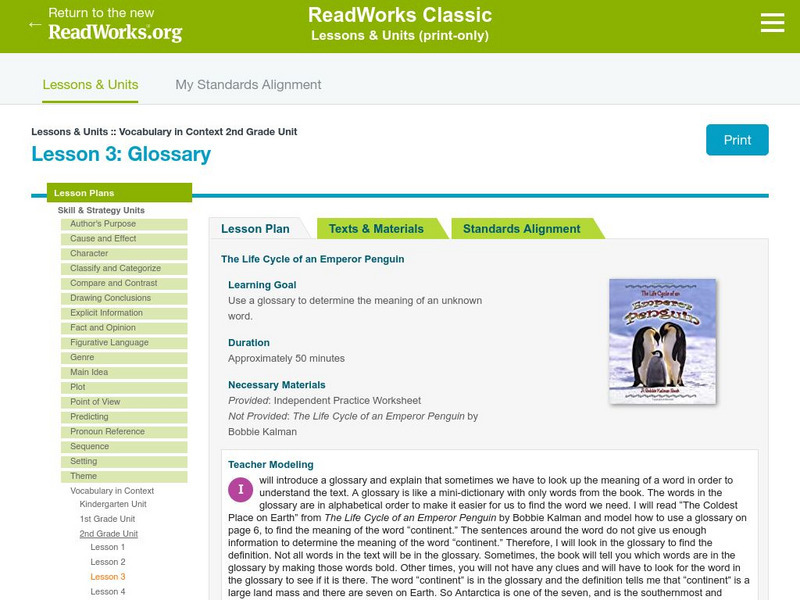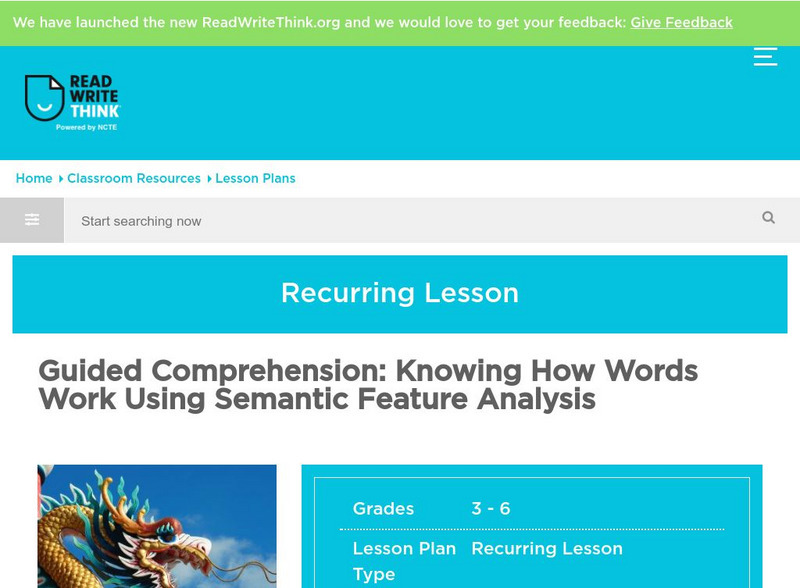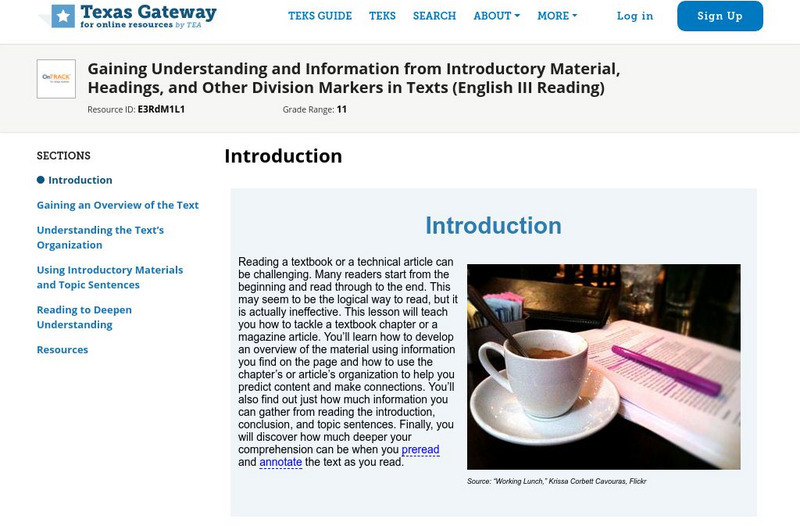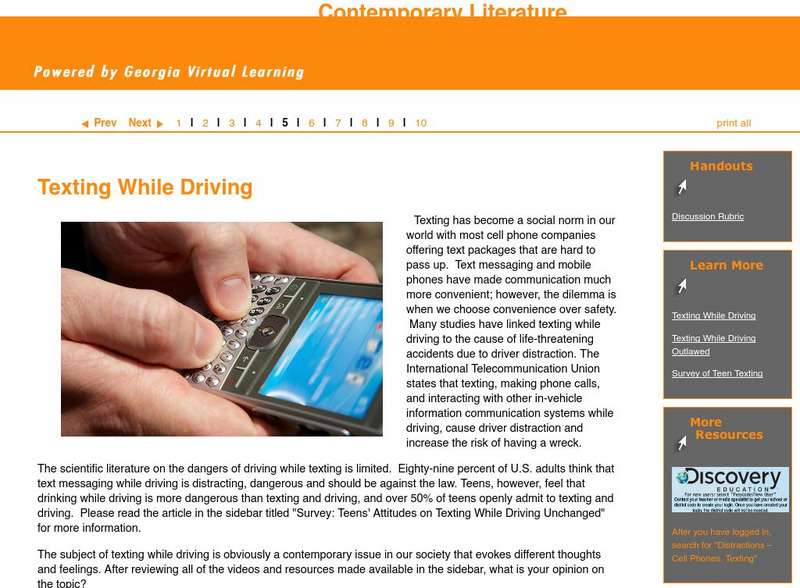Hi, what do you want to do?
InterLink Language Centers
Interlink Language Centers: Reading Exercises Science
An interactive exercise for students to use while developing an understanding of how to read scientific informational texts. The text is presented one paragraph at a time and difficult vocabulary words are defined as footnotes. Then...
Curated OER
Glenco Online: Teaching Today: Reading Comprehension and Considerate Text
Learn the features of "considerate text" and ways to teach students to use these features to increase their comprehension as they read. These features generally apply to non-fiction, especially textbooks.
Scholastic
Scholastic: Teaching With Nonfiction: Teach Text Features
A brief lesson plan, this site offers an example of non-fiction text and a graphic organizer to help orient students to the features they need to use when reading for information.
Read Works
Read Works: Classify and Categorize 4th Grade Unit
[Free Registration/Login Required] A three-lesson unit on classifying and categorizing through which students learn how to organize research into an outline, use text features to locate information, and write a research report. Lessons...
Read Works
Read Works: Using Headings to Determine the Main Idea: The Shark: Silent Hunter
[Free Registration/Login Required] Reading comprehension strategies are the focus of this ReadWorks lesson. Students will pay attention to headings, subheadings, and other text features to help them comprehend nonfiction text. Renee Le's...
Scholastic
Scholastic: Lesson Plan for Nonfiction Comprehension: Skimming Text
Build comprehension by developing reading strategies for use with nonfiction text. This lesson focuses on teaching young scholars to recognize text elements as clues to help them quickly locate key information in text.
PBS
Pbs Learning Media: Walmart Middle School Litercy Initiative
Interactive, student-paced lessons on such literacy skills as categorizing, comparing and contrasting, summarizing, evaluating, determining cause and effect, using text features, connecting, inferring, sequencing, understanding problems...
Read Works
Read Works: Genre Studies: Informational Text Kindergarten Unit: Labeled Diagrams
[Free Registration/Login Required] Lesson uses Bats by Gail Gibbons to teach students how to identify facts learned from labeled diagrams within an informational text. Ideas for direct teaching, guided practice, and independent practice...
ReadWriteThink
Read Write Think: Comprehending Nonfiction Text on the Web
Contains plans for three lessons designed to improve comprehension of nonfiction, especially nonfiction texts on the web. It focuses on identifying text features, locating specific information, and generalizing that information. In...
Read Works
Read Works: After the Floods
[Free Registration/Login Required] This informational text passage shares information about a horrific flood that devastated parts of Pakistan in 2010. This passage is a stand-alone curricular piece that reinforces essential reading...
Read Works
Read Works: Genre 2nd Grade Unit: Encyclopedias
[Free Registration/Login Required] A lesson in which students use the book Children's Illustrated Encyclopedia edited by Jayne Parsons to learn to locate information and find facts about a subject in an encyclopedia. Lesson includes...
Read Works
Read Works: Genre 4th Grade Unit: Strategies for Identifying Genres
[Free Registration/Login Required] A lesson in which students use books from the classroom library to learn strategies that can be utilized to determine the genre of a book and to understand how knowing the genre before reading can aid...
Read Works
Read Works: Genre Studies: Informational Texts: Pictures and Photographs
[Free Registration/Login Required] Lesson uses All About Cats and Kittens by Emily Neye to teach students how to identify facts from photographs and pictures in informational text. Ideas for direct teaching, guided practice, and...
New Zealand Ministry of Education
Nz Ministry of Education: Logging Up Reading Mileage
Students will select and enjoy their own range of contemporary and historical texts, display a knowledge of different genre and their particular content, and identify literary aspects of chosen texts for sustained silent reading. They...
Texas Education Agency
Texas Gateway: Reading Instruction: Content Area Reading Instruction
This website offers a free download of the Research-Based Content Area Reading Instruction booklet. The purpose of this booklet is to provide teachers with research-based and classroom-tested information about each of these aspects of...
Read Works
Read Works: Vocabulary in Context 2nd Grade Unit: Glossary
[Free Registration/Login Required] A lesson plan in which students learn to use a glossary to determine the meanings of unfamiliar words. Lesson utilizes the book The Life Cycle of an Emperor Penguin by Robin Johnson and Bobbie Kalman...
ReadWriteThink
Read Write Think: Guided Comprehension: Semantic Analysis
Lesson introduces students to comprehension of knowing how words work. Students learn semantic feature analysis and examine folktales, myths, and fables using this analysis to better understand these terms and texts.
Texas Education Agency
Texas Gateway: Understand Information From Introductory Material, Headings, Etc.
In this lesson students learn how to develop an overview of the material using information gained from text organization to help predict content and make connections. They also to gather information from reading the introduction,...
Georgia Department of Education
Ga Virtual Learning: Contemporary Issues: Texting While Driving
This lesson focuses on the issue of texting while driving; it features links to articles and a video about the dangers of texting and other distractions while driving and a teen survey with their attitudes on the subject. Students read...
PBS
Pbs Learning Media: Molly of Denali: Fish Camp Game
Use this Molly of Denali digital game to extend and expand students' use of informational text as well as their knowledge of Alaska Native culture.
PBS
Pbs Learning Media: The Worm Turns Lesson Plan: Molly of Denali
This lesson, based on the animated story "The Worm Turns" from the PBS KIDS series MOLLY OF DENALI, helps children use several types of informational texts to gather facts. In the video, Molly and her friends are frightened after hearing...
ReadWriteThink
Read Write Think: Using Science Texts to Teach the Organization of Nonfiction
Contains plans for three lessons that use science textbooks to teach about the organizational features of nonfiction such as labels, captions, headings, and fonts. In addition to objectives and standards, this instructional plan contains...
ReadWriteThink
Read Write Think: Children's Book Author Eric Carle Was Born on This Day in 1929
Eric Carle's illustrations feature paper collages, so after reading some of Carle's books you might create your own word collage for an added challenge. Students will choose a scene, an emotion, an animal, or a person. Then students...
Other
Kid Bibs: Effective Use of Textbook Features
Here, parents and teachers can find tips for helping young readers understand the expository writing found in textbooks.






